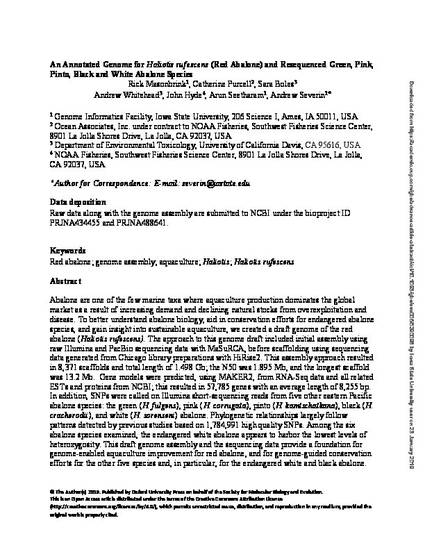
Abalone are one of the few marine taxa where aquaculture production dominates the global market as a result of increasing demand and declining natural stocks from overexploitation and disease. To better understand abalone biology, aid in conservation efforts for endangered abalone species, and gain insight into sustainable aquaculture, we created a draft genome of the red abalone (Haliotis rufescens). The approach to this genome draft included initial assembly using raw Illumina and PacBio sequencing data with MaSuRCA, before scaffolding using sequencing data generated from Chicago library preparations with HiRise2. This assembly approach resulted in 8,371 scaffolds and total length of 1.498 Gb; the N50 was 1.895 Mb, and the longest scaffold was 13.2 Mb. Gene models were predicted, using MAKER2, from RNA-Seq data and all related ESTs and proteins from NCBI; this resulted in 57,785 genes with an average length of 8,255 bp. In addition, SNPs were called on Illumina short-sequencing reads from five other eastern Pacific abalone species: the green (H. fulgens), pink (H. corrugata), pinto (H. kamtschatkana), black (H. cracherodii), and white (H. sorenseni) abalone. Phylogenetic relationships largely follow patterns detected by previous studies based on 1,784,991 high quality SNPs. Among the six abalone species examined, the endangered white abalone appears to harbor the lowest levels of heterozygosity. This draft genome assembly and the sequencing data provide a foundation for genome-enabled aquaculture improvement for red abalone, and for genome-guided conservation efforts for the other five species and, in particular, for the endangered white and black abalone.
Available at: http://works.bepress.com/arun-seetharam/17/

This is a manuscript of an article published as Masonbrink, Rick, Catherine Purcell, Sara Boles, Andrew Whitehead, John Hyde, Arun Seetharam, and Andrew Severin. "An Annotated Genome for Haliotis rufescens (Red Abalone) and Resequenced Green, Pink, Pinto, Black and White Abalone Species." Genome Biology and Evolution (2019). doi: 10.1093/gbe/evz006.